Theory and Practice of Counseling and Psychotherapy
VerifiedAdded on 2022/08/23
|18
|4764
|22
AI Summary
Contribute Materials
Your contribution can guide someone’s learning journey. Share your
documents today.

Running head: COUNSELLING
`
COUNSELLING
Name of the Student
Name of the University
Author note
`
COUNSELLING
Name of the Student
Name of the University
Author note
Secure Best Marks with AI Grader
Need help grading? Try our AI Grader for instant feedback on your assignments.
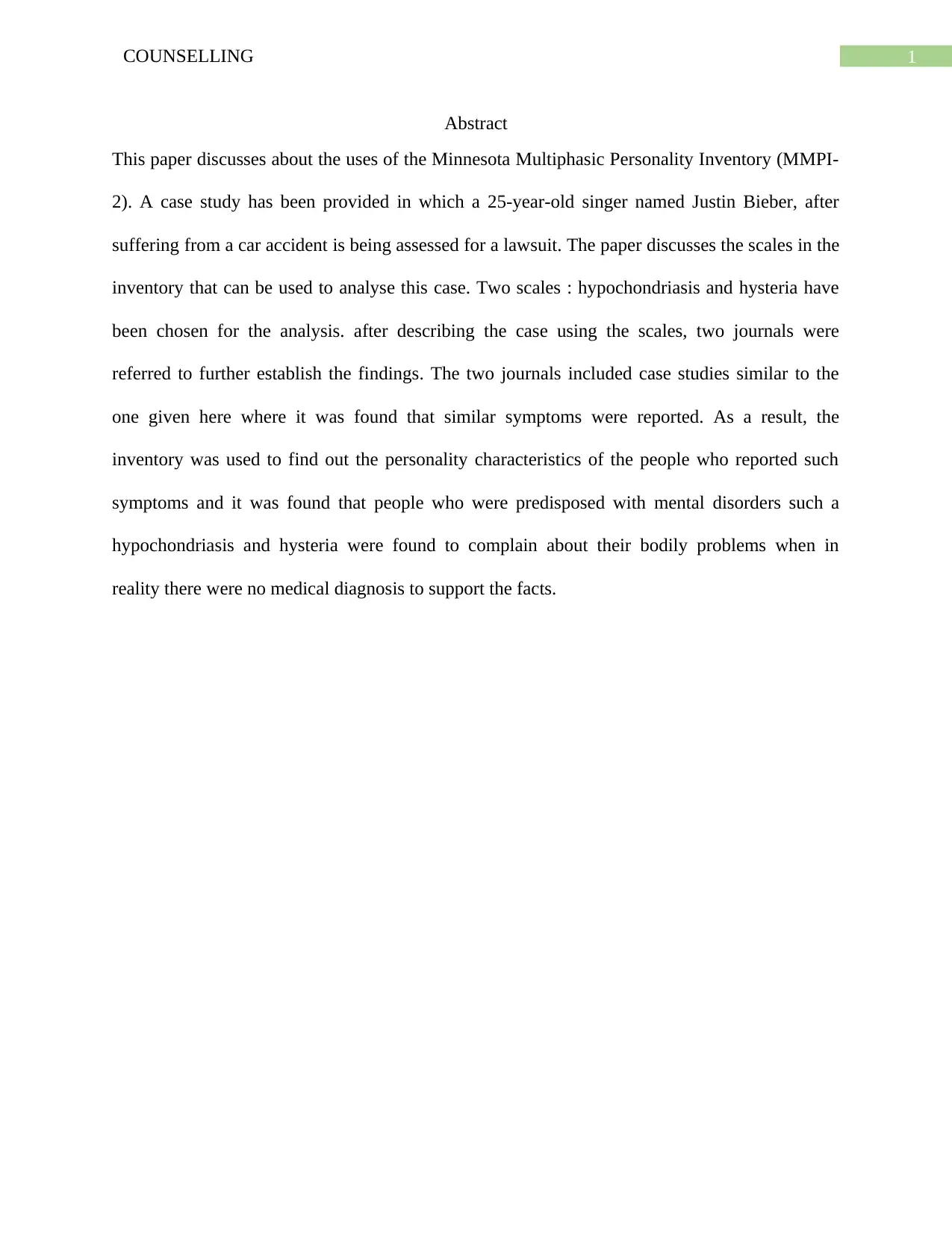
1COUNSELLING
Abstract
This paper discusses about the uses of the Minnesota Multiphasic Personality Inventory (MMPI-
2). A case study has been provided in which a 25-year-old singer named Justin Bieber, after
suffering from a car accident is being assessed for a lawsuit. The paper discusses the scales in the
inventory that can be used to analyse this case. Two scales : hypochondriasis and hysteria have
been chosen for the analysis. after describing the case using the scales, two journals were
referred to further establish the findings. The two journals included case studies similar to the
one given here where it was found that similar symptoms were reported. As a result, the
inventory was used to find out the personality characteristics of the people who reported such
symptoms and it was found that people who were predisposed with mental disorders such a
hypochondriasis and hysteria were found to complain about their bodily problems when in
reality there were no medical diagnosis to support the facts.
Abstract
This paper discusses about the uses of the Minnesota Multiphasic Personality Inventory (MMPI-
2). A case study has been provided in which a 25-year-old singer named Justin Bieber, after
suffering from a car accident is being assessed for a lawsuit. The paper discusses the scales in the
inventory that can be used to analyse this case. Two scales : hypochondriasis and hysteria have
been chosen for the analysis. after describing the case using the scales, two journals were
referred to further establish the findings. The two journals included case studies similar to the
one given here where it was found that similar symptoms were reported. As a result, the
inventory was used to find out the personality characteristics of the people who reported such
symptoms and it was found that people who were predisposed with mental disorders such a
hypochondriasis and hysteria were found to complain about their bodily problems when in
reality there were no medical diagnosis to support the facts.
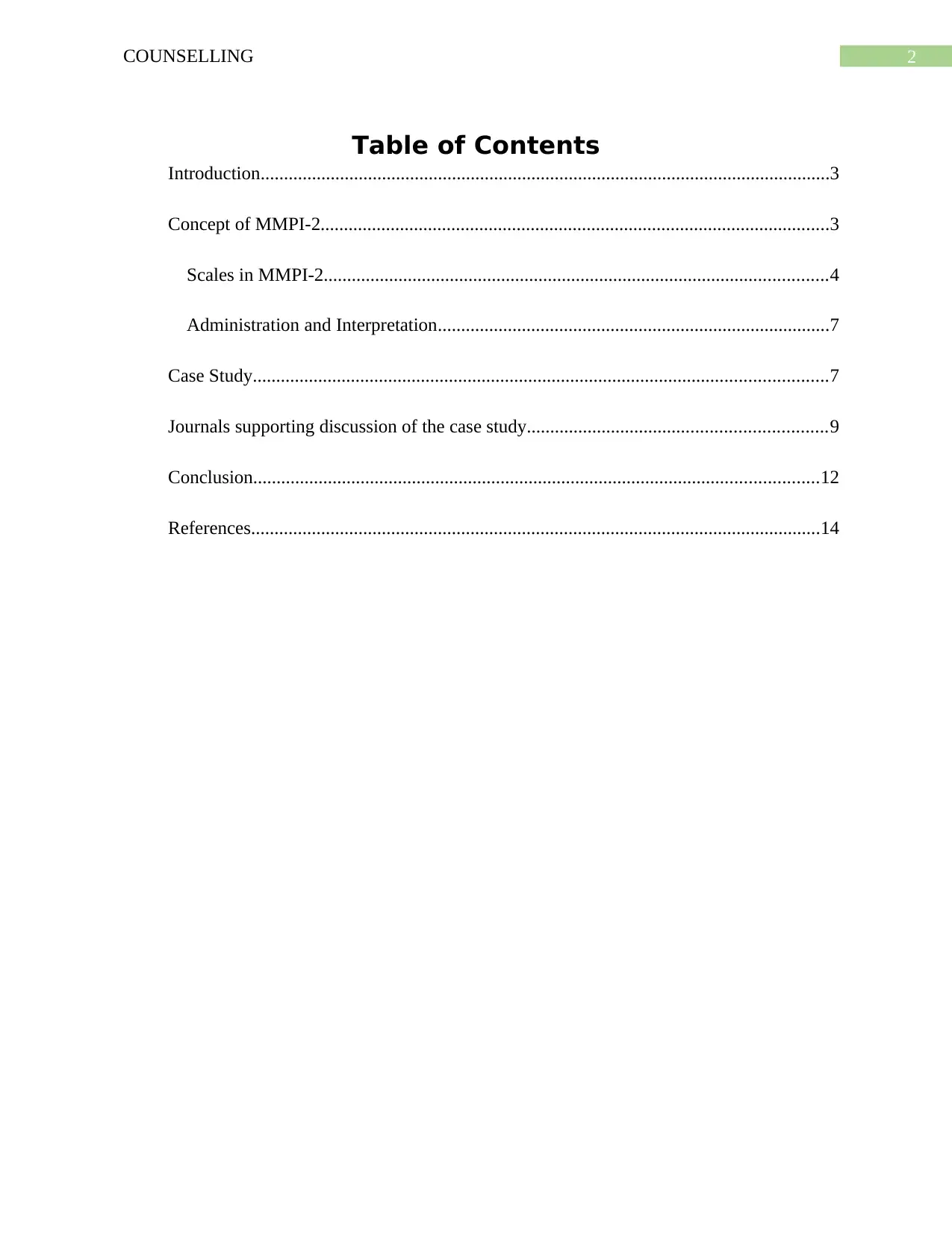
2COUNSELLING
Table of Contents
Introduction..........................................................................................................................3
Concept of MMPI-2.............................................................................................................3
Scales in MMPI-2............................................................................................................4
Administration and Interpretation....................................................................................7
Case Study...........................................................................................................................7
Journals supporting discussion of the case study................................................................9
Conclusion.........................................................................................................................12
References..........................................................................................................................14
Table of Contents
Introduction..........................................................................................................................3
Concept of MMPI-2.............................................................................................................3
Scales in MMPI-2............................................................................................................4
Administration and Interpretation....................................................................................7
Case Study...........................................................................................................................7
Journals supporting discussion of the case study................................................................9
Conclusion.........................................................................................................................12
References..........................................................................................................................14
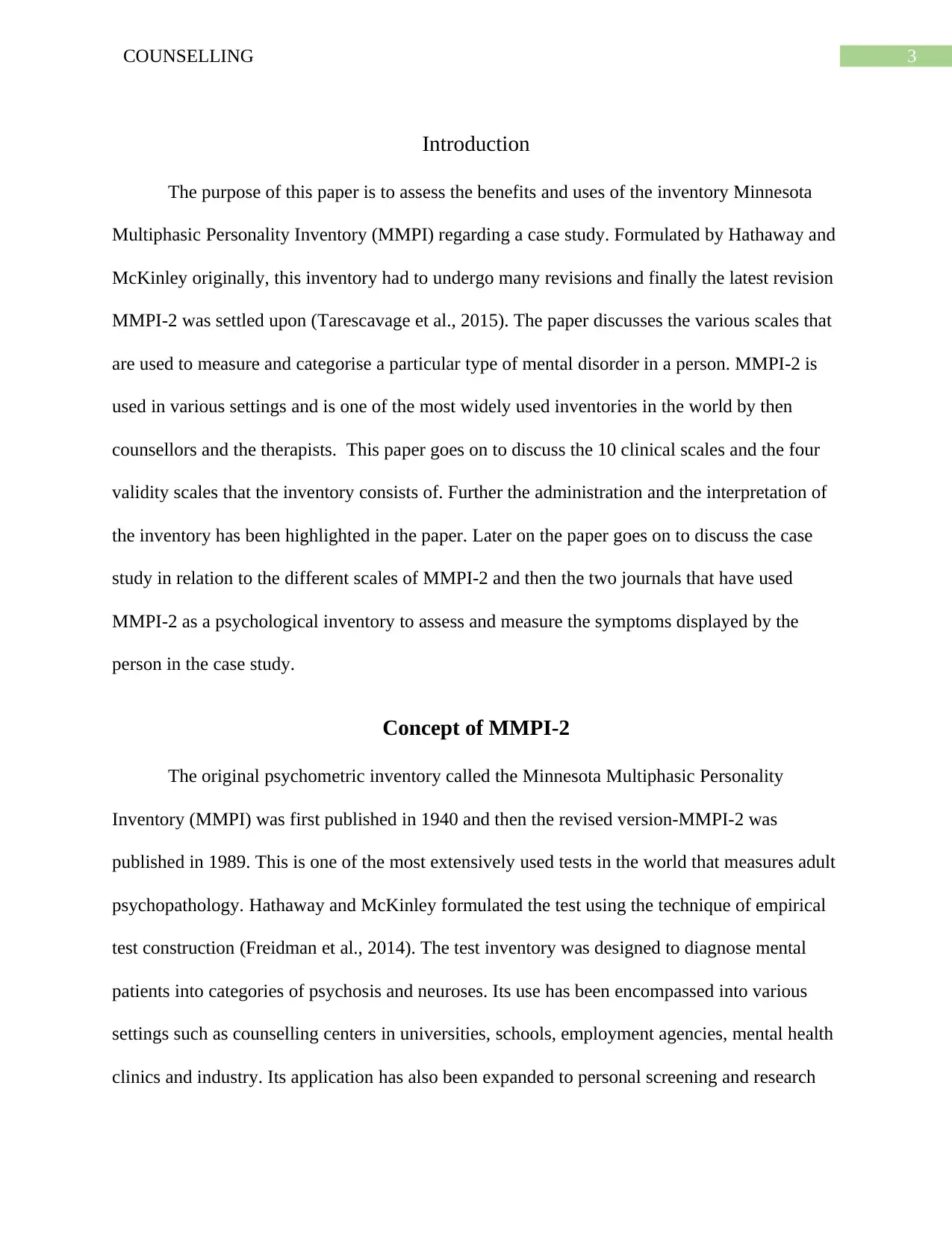
3COUNSELLING
Introduction
The purpose of this paper is to assess the benefits and uses of the inventory Minnesota
Multiphasic Personality Inventory (MMPI) regarding a case study. Formulated by Hathaway and
McKinley originally, this inventory had to undergo many revisions and finally the latest revision
MMPI-2 was settled upon (Tarescavage et al., 2015). The paper discusses the various scales that
are used to measure and categorise a particular type of mental disorder in a person. MMPI-2 is
used in various settings and is one of the most widely used inventories in the world by then
counsellors and the therapists. This paper goes on to discuss the 10 clinical scales and the four
validity scales that the inventory consists of. Further the administration and the interpretation of
the inventory has been highlighted in the paper. Later on the paper goes on to discuss the case
study in relation to the different scales of MMPI-2 and then the two journals that have used
MMPI-2 as a psychological inventory to assess and measure the symptoms displayed by the
person in the case study.
Concept of MMPI-2
The original psychometric inventory called the Minnesota Multiphasic Personality
Inventory (MMPI) was first published in 1940 and then the revised version-MMPI-2 was
published in 1989. This is one of the most extensively used tests in the world that measures adult
psychopathology. Hathaway and McKinley formulated the test using the technique of empirical
test construction (Freidman et al., 2014). The test inventory was designed to diagnose mental
patients into categories of psychosis and neuroses. Its use has been encompassed into various
settings such as counselling centers in universities, schools, employment agencies, mental health
clinics and industry. Its application has also been expanded to personal screening and research
Introduction
The purpose of this paper is to assess the benefits and uses of the inventory Minnesota
Multiphasic Personality Inventory (MMPI) regarding a case study. Formulated by Hathaway and
McKinley originally, this inventory had to undergo many revisions and finally the latest revision
MMPI-2 was settled upon (Tarescavage et al., 2015). The paper discusses the various scales that
are used to measure and categorise a particular type of mental disorder in a person. MMPI-2 is
used in various settings and is one of the most widely used inventories in the world by then
counsellors and the therapists. This paper goes on to discuss the 10 clinical scales and the four
validity scales that the inventory consists of. Further the administration and the interpretation of
the inventory has been highlighted in the paper. Later on the paper goes on to discuss the case
study in relation to the different scales of MMPI-2 and then the two journals that have used
MMPI-2 as a psychological inventory to assess and measure the symptoms displayed by the
person in the case study.
Concept of MMPI-2
The original psychometric inventory called the Minnesota Multiphasic Personality
Inventory (MMPI) was first published in 1940 and then the revised version-MMPI-2 was
published in 1989. This is one of the most extensively used tests in the world that measures adult
psychopathology. Hathaway and McKinley formulated the test using the technique of empirical
test construction (Freidman et al., 2014). The test inventory was designed to diagnose mental
patients into categories of psychosis and neuroses. Its use has been encompassed into various
settings such as counselling centers in universities, schools, employment agencies, mental health
clinics and industry. Its application has also been expanded to personal screening and research
Secure Best Marks with AI Grader
Need help grading? Try our AI Grader for instant feedback on your assignments.
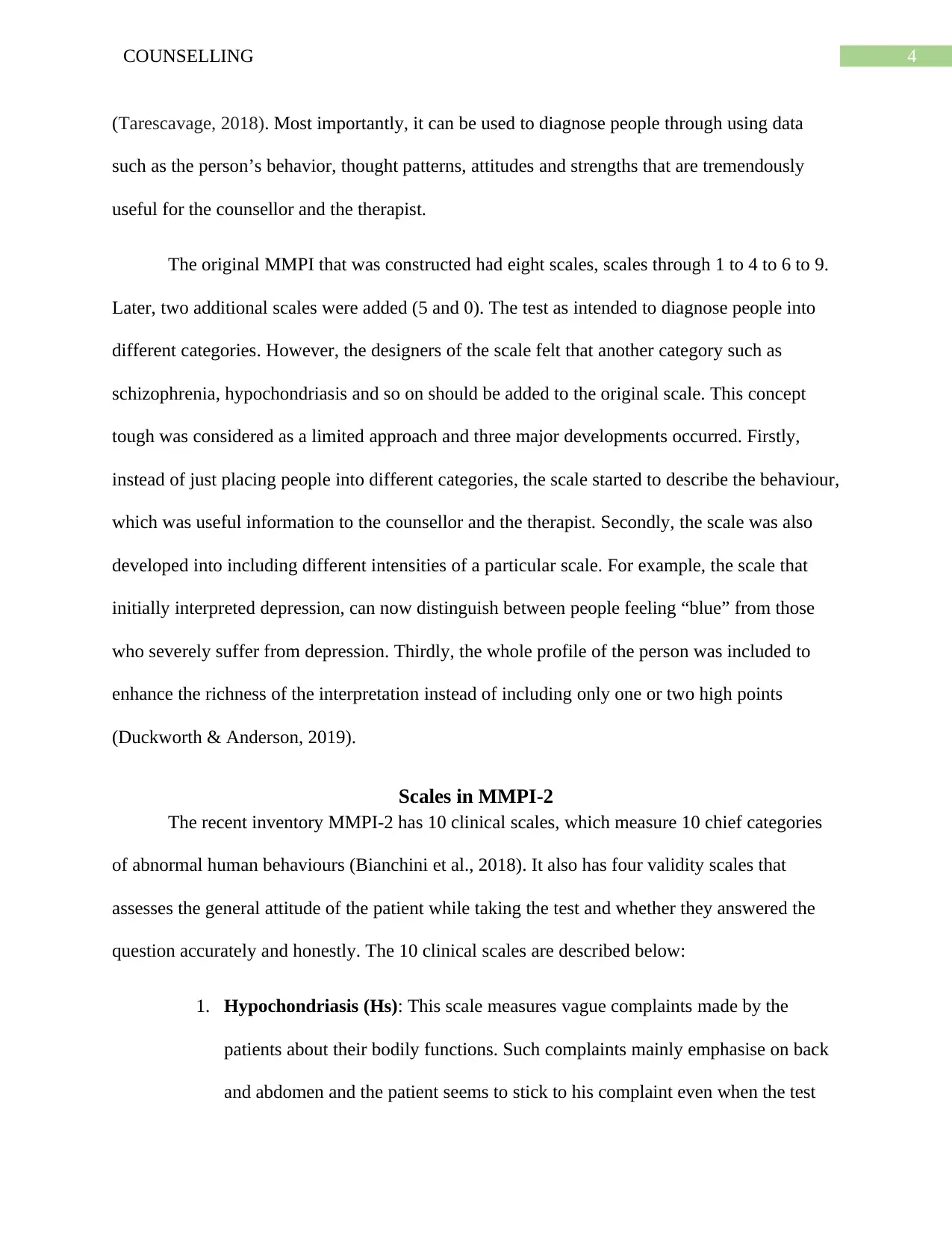
4COUNSELLING
(Tarescavage, 2018). Most importantly, it can be used to diagnose people through using data
such as the person’s behavior, thought patterns, attitudes and strengths that are tremendously
useful for the counsellor and the therapist.
The original MMPI that was constructed had eight scales, scales through 1 to 4 to 6 to 9.
Later, two additional scales were added (5 and 0). The test as intended to diagnose people into
different categories. However, the designers of the scale felt that another category such as
schizophrenia, hypochondriasis and so on should be added to the original scale. This concept
tough was considered as a limited approach and three major developments occurred. Firstly,
instead of just placing people into different categories, the scale started to describe the behaviour,
which was useful information to the counsellor and the therapist. Secondly, the scale was also
developed into including different intensities of a particular scale. For example, the scale that
initially interpreted depression, can now distinguish between people feeling “blue” from those
who severely suffer from depression. Thirdly, the whole profile of the person was included to
enhance the richness of the interpretation instead of including only one or two high points
(Duckworth & Anderson, 2019).
Scales in MMPI-2
The recent inventory MMPI-2 has 10 clinical scales, which measure 10 chief categories
of abnormal human behaviours (Bianchini et al., 2018). It also has four validity scales that
assesses the general attitude of the patient while taking the test and whether they answered the
question accurately and honestly. The 10 clinical scales are described below:
1. Hypochondriasis (Hs): This scale measures vague complaints made by the
patients about their bodily functions. Such complaints mainly emphasise on back
and abdomen and the patient seems to stick to his complaint even when the test
(Tarescavage, 2018). Most importantly, it can be used to diagnose people through using data
such as the person’s behavior, thought patterns, attitudes and strengths that are tremendously
useful for the counsellor and the therapist.
The original MMPI that was constructed had eight scales, scales through 1 to 4 to 6 to 9.
Later, two additional scales were added (5 and 0). The test as intended to diagnose people into
different categories. However, the designers of the scale felt that another category such as
schizophrenia, hypochondriasis and so on should be added to the original scale. This concept
tough was considered as a limited approach and three major developments occurred. Firstly,
instead of just placing people into different categories, the scale started to describe the behaviour,
which was useful information to the counsellor and the therapist. Secondly, the scale was also
developed into including different intensities of a particular scale. For example, the scale that
initially interpreted depression, can now distinguish between people feeling “blue” from those
who severely suffer from depression. Thirdly, the whole profile of the person was included to
enhance the richness of the interpretation instead of including only one or two high points
(Duckworth & Anderson, 2019).
Scales in MMPI-2
The recent inventory MMPI-2 has 10 clinical scales, which measure 10 chief categories
of abnormal human behaviours (Bianchini et al., 2018). It also has four validity scales that
assesses the general attitude of the patient while taking the test and whether they answered the
question accurately and honestly. The 10 clinical scales are described below:
1. Hypochondriasis (Hs): This scale measures vague complaints made by the
patients about their bodily functions. Such complaints mainly emphasise on back
and abdomen and the patient seems to stick to his complaint even when the test
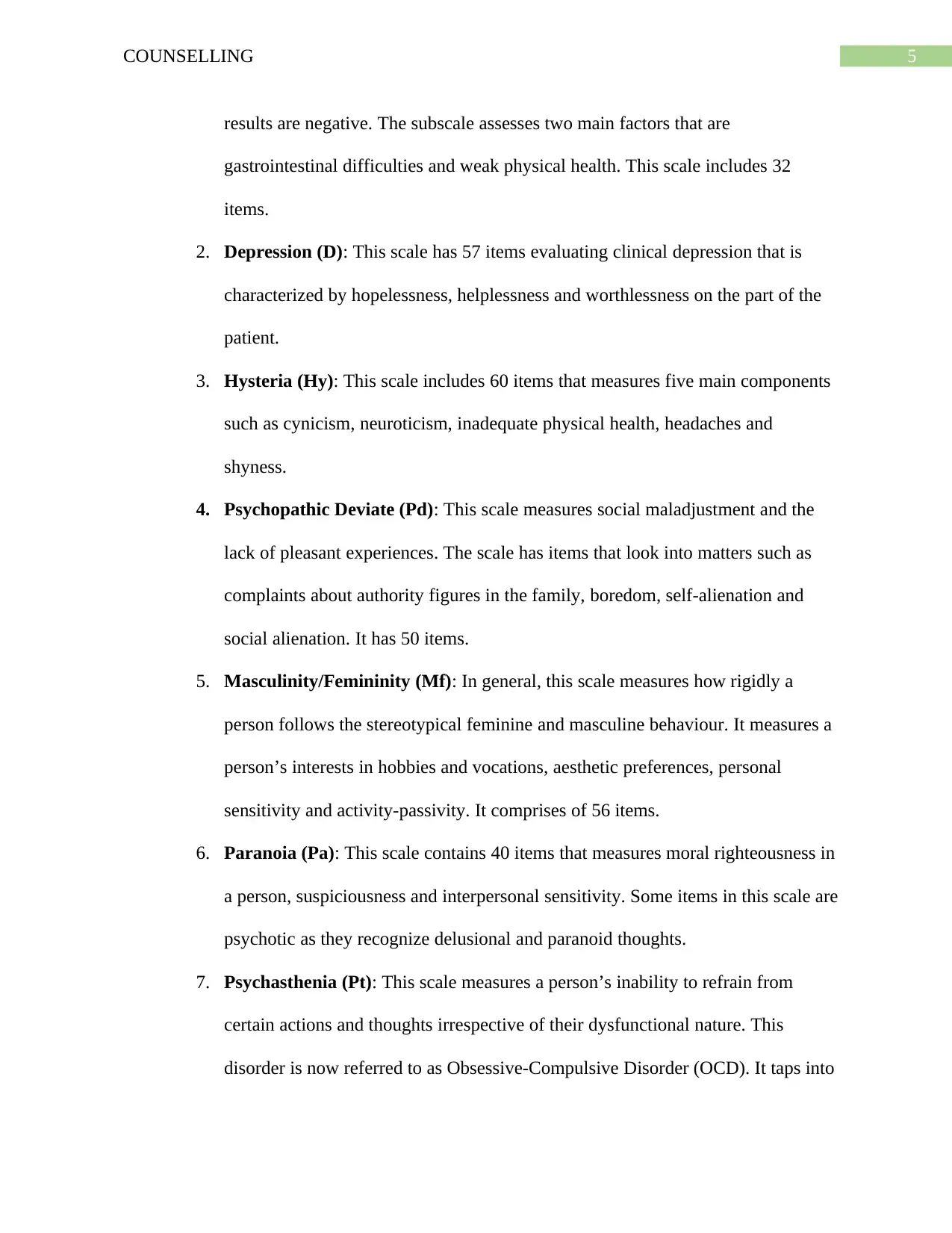
5COUNSELLING
results are negative. The subscale assesses two main factors that are
gastrointestinal difficulties and weak physical health. This scale includes 32
items.
2. Depression (D): This scale has 57 items evaluating clinical depression that is
characterized by hopelessness, helplessness and worthlessness on the part of the
patient.
3. Hysteria (Hy): This scale includes 60 items that measures five main components
such as cynicism, neuroticism, inadequate physical health, headaches and
shyness.
4. Psychopathic Deviate (Pd): This scale measures social maladjustment and the
lack of pleasant experiences. The scale has items that look into matters such as
complaints about authority figures in the family, boredom, self-alienation and
social alienation. It has 50 items.
5. Masculinity/Femininity (Mf): In general, this scale measures how rigidly a
person follows the stereotypical feminine and masculine behaviour. It measures a
person’s interests in hobbies and vocations, aesthetic preferences, personal
sensitivity and activity-passivity. It comprises of 56 items.
6. Paranoia (Pa): This scale contains 40 items that measures moral righteousness in
a person, suspiciousness and interpersonal sensitivity. Some items in this scale are
psychotic as they recognize delusional and paranoid thoughts.
7. Psychasthenia (Pt): This scale measures a person’s inability to refrain from
certain actions and thoughts irrespective of their dysfunctional nature. This
disorder is now referred to as Obsessive-Compulsive Disorder (OCD). It taps into
results are negative. The subscale assesses two main factors that are
gastrointestinal difficulties and weak physical health. This scale includes 32
items.
2. Depression (D): This scale has 57 items evaluating clinical depression that is
characterized by hopelessness, helplessness and worthlessness on the part of the
patient.
3. Hysteria (Hy): This scale includes 60 items that measures five main components
such as cynicism, neuroticism, inadequate physical health, headaches and
shyness.
4. Psychopathic Deviate (Pd): This scale measures social maladjustment and the
lack of pleasant experiences. The scale has items that look into matters such as
complaints about authority figures in the family, boredom, self-alienation and
social alienation. It has 50 items.
5. Masculinity/Femininity (Mf): In general, this scale measures how rigidly a
person follows the stereotypical feminine and masculine behaviour. It measures a
person’s interests in hobbies and vocations, aesthetic preferences, personal
sensitivity and activity-passivity. It comprises of 56 items.
6. Paranoia (Pa): This scale contains 40 items that measures moral righteousness in
a person, suspiciousness and interpersonal sensitivity. Some items in this scale are
psychotic as they recognize delusional and paranoid thoughts.
7. Psychasthenia (Pt): This scale measures a person’s inability to refrain from
certain actions and thoughts irrespective of their dysfunctional nature. This
disorder is now referred to as Obsessive-Compulsive Disorder (OCD). It taps into
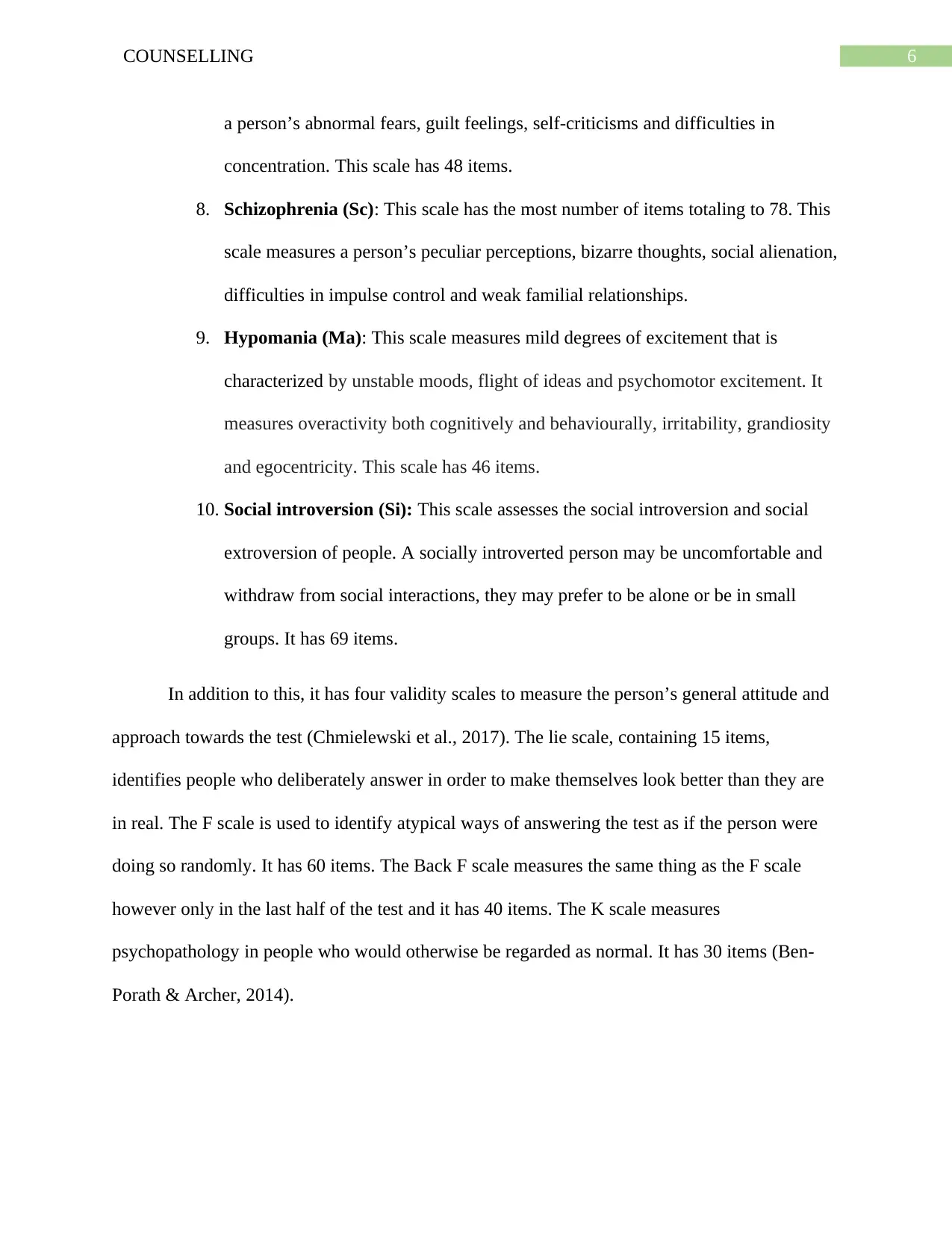
6COUNSELLING
a person’s abnormal fears, guilt feelings, self-criticisms and difficulties in
concentration. This scale has 48 items.
8. Schizophrenia (Sc): This scale has the most number of items totaling to 78. This
scale measures a person’s peculiar perceptions, bizarre thoughts, social alienation,
difficulties in impulse control and weak familial relationships.
9. Hypomania (Ma): This scale measures mild degrees of excitement that is
characterized by unstable moods, flight of ideas and psychomotor excitement. It
measures overactivity both cognitively and behaviourally, irritability, grandiosity
and egocentricity. This scale has 46 items.
10. Social introversion (Si): This scale assesses the social introversion and social
extroversion of people. A socially introverted person may be uncomfortable and
withdraw from social interactions, they may prefer to be alone or be in small
groups. It has 69 items.
In addition to this, it has four validity scales to measure the person’s general attitude and
approach towards the test (Chmielewski et al., 2017). The lie scale, containing 15 items,
identifies people who deliberately answer in order to make themselves look better than they are
in real. The F scale is used to identify atypical ways of answering the test as if the person were
doing so randomly. It has 60 items. The Back F scale measures the same thing as the F scale
however only in the last half of the test and it has 40 items. The K scale measures
psychopathology in people who would otherwise be regarded as normal. It has 30 items (Ben-
Porath & Archer, 2014).
a person’s abnormal fears, guilt feelings, self-criticisms and difficulties in
concentration. This scale has 48 items.
8. Schizophrenia (Sc): This scale has the most number of items totaling to 78. This
scale measures a person’s peculiar perceptions, bizarre thoughts, social alienation,
difficulties in impulse control and weak familial relationships.
9. Hypomania (Ma): This scale measures mild degrees of excitement that is
characterized by unstable moods, flight of ideas and psychomotor excitement. It
measures overactivity both cognitively and behaviourally, irritability, grandiosity
and egocentricity. This scale has 46 items.
10. Social introversion (Si): This scale assesses the social introversion and social
extroversion of people. A socially introverted person may be uncomfortable and
withdraw from social interactions, they may prefer to be alone or be in small
groups. It has 69 items.
In addition to this, it has four validity scales to measure the person’s general attitude and
approach towards the test (Chmielewski et al., 2017). The lie scale, containing 15 items,
identifies people who deliberately answer in order to make themselves look better than they are
in real. The F scale is used to identify atypical ways of answering the test as if the person were
doing so randomly. It has 60 items. The Back F scale measures the same thing as the F scale
however only in the last half of the test and it has 40 items. The K scale measures
psychopathology in people who would otherwise be regarded as normal. It has 30 items (Ben-
Porath & Archer, 2014).
Paraphrase This Document
Need a fresh take? Get an instant paraphrase of this document with our AI Paraphraser
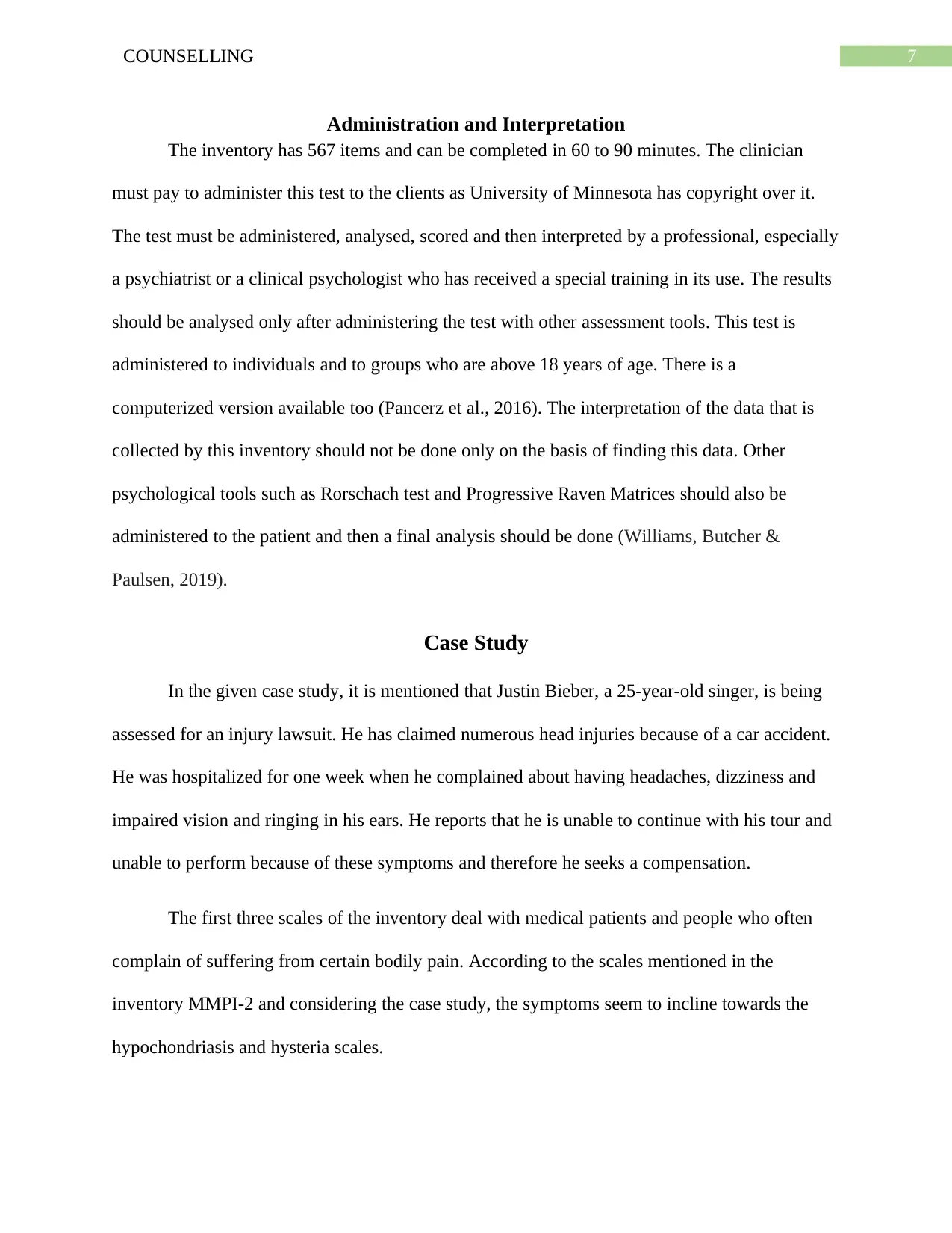
7COUNSELLING
Administration and Interpretation
The inventory has 567 items and can be completed in 60 to 90 minutes. The clinician
must pay to administer this test to the clients as University of Minnesota has copyright over it.
The test must be administered, analysed, scored and then interpreted by a professional, especially
a psychiatrist or a clinical psychologist who has received a special training in its use. The results
should be analysed only after administering the test with other assessment tools. This test is
administered to individuals and to groups who are above 18 years of age. There is a
computerized version available too (Pancerz et al., 2016). The interpretation of the data that is
collected by this inventory should not be done only on the basis of finding this data. Other
psychological tools such as Rorschach test and Progressive Raven Matrices should also be
administered to the patient and then a final analysis should be done (Williams, Butcher &
Paulsen, 2019).
Case Study
In the given case study, it is mentioned that Justin Bieber, a 25-year-old singer, is being
assessed for an injury lawsuit. He has claimed numerous head injuries because of a car accident.
He was hospitalized for one week when he complained about having headaches, dizziness and
impaired vision and ringing in his ears. He reports that he is unable to continue with his tour and
unable to perform because of these symptoms and therefore he seeks a compensation.
The first three scales of the inventory deal with medical patients and people who often
complain of suffering from certain bodily pain. According to the scales mentioned in the
inventory MMPI-2 and considering the case study, the symptoms seem to incline towards the
hypochondriasis and hysteria scales.
Administration and Interpretation
The inventory has 567 items and can be completed in 60 to 90 minutes. The clinician
must pay to administer this test to the clients as University of Minnesota has copyright over it.
The test must be administered, analysed, scored and then interpreted by a professional, especially
a psychiatrist or a clinical psychologist who has received a special training in its use. The results
should be analysed only after administering the test with other assessment tools. This test is
administered to individuals and to groups who are above 18 years of age. There is a
computerized version available too (Pancerz et al., 2016). The interpretation of the data that is
collected by this inventory should not be done only on the basis of finding this data. Other
psychological tools such as Rorschach test and Progressive Raven Matrices should also be
administered to the patient and then a final analysis should be done (Williams, Butcher &
Paulsen, 2019).
Case Study
In the given case study, it is mentioned that Justin Bieber, a 25-year-old singer, is being
assessed for an injury lawsuit. He has claimed numerous head injuries because of a car accident.
He was hospitalized for one week when he complained about having headaches, dizziness and
impaired vision and ringing in his ears. He reports that he is unable to continue with his tour and
unable to perform because of these symptoms and therefore he seeks a compensation.
The first three scales of the inventory deal with medical patients and people who often
complain of suffering from certain bodily pain. According to the scales mentioned in the
inventory MMPI-2 and considering the case study, the symptoms seem to incline towards the
hypochondriasis and hysteria scales.
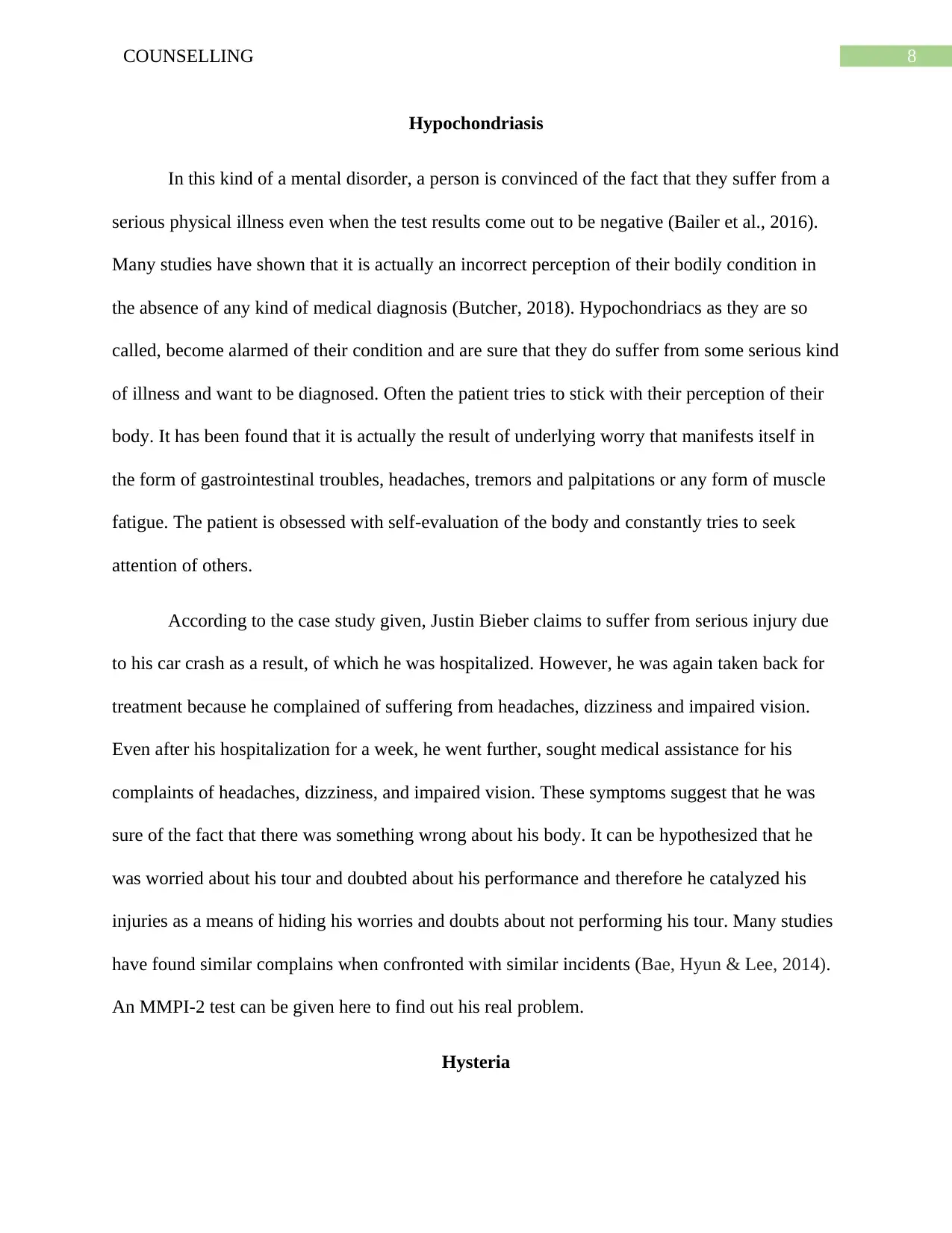
8COUNSELLING
Hypochondriasis
In this kind of a mental disorder, a person is convinced of the fact that they suffer from a
serious physical illness even when the test results come out to be negative (Bailer et al., 2016).
Many studies have shown that it is actually an incorrect perception of their bodily condition in
the absence of any kind of medical diagnosis (Butcher, 2018). Hypochondriacs as they are so
called, become alarmed of their condition and are sure that they do suffer from some serious kind
of illness and want to be diagnosed. Often the patient tries to stick with their perception of their
body. It has been found that it is actually the result of underlying worry that manifests itself in
the form of gastrointestinal troubles, headaches, tremors and palpitations or any form of muscle
fatigue. The patient is obsessed with self-evaluation of the body and constantly tries to seek
attention of others.
According to the case study given, Justin Bieber claims to suffer from serious injury due
to his car crash as a result, of which he was hospitalized. However, he was again taken back for
treatment because he complained of suffering from headaches, dizziness and impaired vision.
Even after his hospitalization for a week, he went further, sought medical assistance for his
complaints of headaches, dizziness, and impaired vision. These symptoms suggest that he was
sure of the fact that there was something wrong about his body. It can be hypothesized that he
was worried about his tour and doubted about his performance and therefore he catalyzed his
injuries as a means of hiding his worries and doubts about not performing his tour. Many studies
have found similar complains when confronted with similar incidents (Bae, Hyun & Lee, 2014).
An MMPI-2 test can be given here to find out his real problem.
Hysteria
Hypochondriasis
In this kind of a mental disorder, a person is convinced of the fact that they suffer from a
serious physical illness even when the test results come out to be negative (Bailer et al., 2016).
Many studies have shown that it is actually an incorrect perception of their bodily condition in
the absence of any kind of medical diagnosis (Butcher, 2018). Hypochondriacs as they are so
called, become alarmed of their condition and are sure that they do suffer from some serious kind
of illness and want to be diagnosed. Often the patient tries to stick with their perception of their
body. It has been found that it is actually the result of underlying worry that manifests itself in
the form of gastrointestinal troubles, headaches, tremors and palpitations or any form of muscle
fatigue. The patient is obsessed with self-evaluation of the body and constantly tries to seek
attention of others.
According to the case study given, Justin Bieber claims to suffer from serious injury due
to his car crash as a result, of which he was hospitalized. However, he was again taken back for
treatment because he complained of suffering from headaches, dizziness and impaired vision.
Even after his hospitalization for a week, he went further, sought medical assistance for his
complaints of headaches, dizziness, and impaired vision. These symptoms suggest that he was
sure of the fact that there was something wrong about his body. It can be hypothesized that he
was worried about his tour and doubted about his performance and therefore he catalyzed his
injuries as a means of hiding his worries and doubts about not performing his tour. Many studies
have found similar complains when confronted with similar incidents (Bae, Hyun & Lee, 2014).
An MMPI-2 test can be given here to find out his real problem.
Hysteria
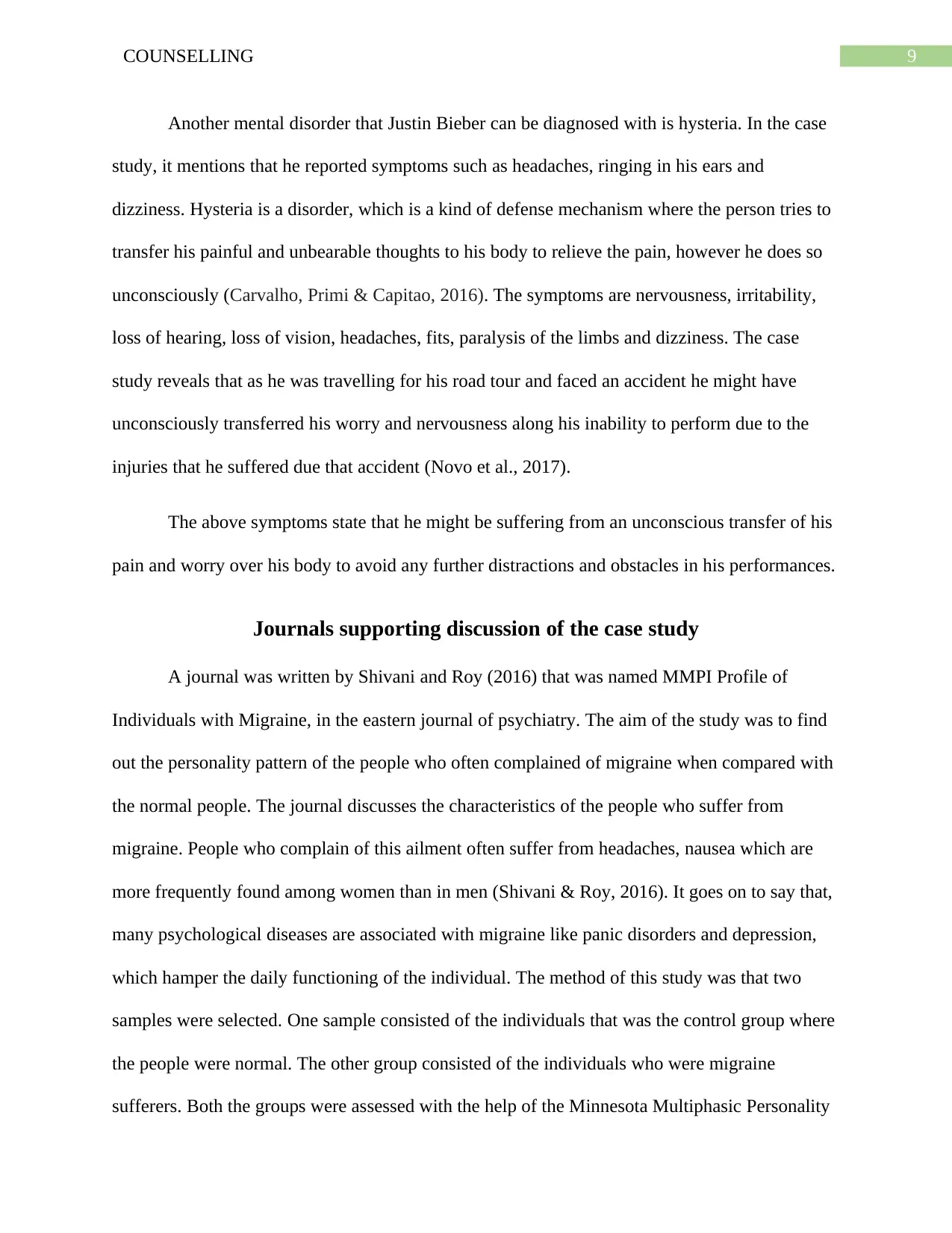
9COUNSELLING
Another mental disorder that Justin Bieber can be diagnosed with is hysteria. In the case
study, it mentions that he reported symptoms such as headaches, ringing in his ears and
dizziness. Hysteria is a disorder, which is a kind of defense mechanism where the person tries to
transfer his painful and unbearable thoughts to his body to relieve the pain, however he does so
unconsciously (Carvalho, Primi & Capitao, 2016). The symptoms are nervousness, irritability,
loss of hearing, loss of vision, headaches, fits, paralysis of the limbs and dizziness. The case
study reveals that as he was travelling for his road tour and faced an accident he might have
unconsciously transferred his worry and nervousness along his inability to perform due to the
injuries that he suffered due that accident (Novo et al., 2017).
The above symptoms state that he might be suffering from an unconscious transfer of his
pain and worry over his body to avoid any further distractions and obstacles in his performances.
Journals supporting discussion of the case study
A journal was written by Shivani and Roy (2016) that was named MMPI Profile of
Individuals with Migraine, in the eastern journal of psychiatry. The aim of the study was to find
out the personality pattern of the people who often complained of migraine when compared with
the normal people. The journal discusses the characteristics of the people who suffer from
migraine. People who complain of this ailment often suffer from headaches, nausea which are
more frequently found among women than in men (Shivani & Roy, 2016). It goes on to say that,
many psychological diseases are associated with migraine like panic disorders and depression,
which hamper the daily functioning of the individual. The method of this study was that two
samples were selected. One sample consisted of the individuals that was the control group where
the people were normal. The other group consisted of the individuals who were migraine
sufferers. Both the groups were assessed with the help of the Minnesota Multiphasic Personality
Another mental disorder that Justin Bieber can be diagnosed with is hysteria. In the case
study, it mentions that he reported symptoms such as headaches, ringing in his ears and
dizziness. Hysteria is a disorder, which is a kind of defense mechanism where the person tries to
transfer his painful and unbearable thoughts to his body to relieve the pain, however he does so
unconsciously (Carvalho, Primi & Capitao, 2016). The symptoms are nervousness, irritability,
loss of hearing, loss of vision, headaches, fits, paralysis of the limbs and dizziness. The case
study reveals that as he was travelling for his road tour and faced an accident he might have
unconsciously transferred his worry and nervousness along his inability to perform due to the
injuries that he suffered due that accident (Novo et al., 2017).
The above symptoms state that he might be suffering from an unconscious transfer of his
pain and worry over his body to avoid any further distractions and obstacles in his performances.
Journals supporting discussion of the case study
A journal was written by Shivani and Roy (2016) that was named MMPI Profile of
Individuals with Migraine, in the eastern journal of psychiatry. The aim of the study was to find
out the personality pattern of the people who often complained of migraine when compared with
the normal people. The journal discusses the characteristics of the people who suffer from
migraine. People who complain of this ailment often suffer from headaches, nausea which are
more frequently found among women than in men (Shivani & Roy, 2016). It goes on to say that,
many psychological diseases are associated with migraine like panic disorders and depression,
which hamper the daily functioning of the individual. The method of this study was that two
samples were selected. One sample consisted of the individuals that was the control group where
the people were normal. The other group consisted of the individuals who were migraine
sufferers. Both the groups were assessed with the help of the Minnesota Multiphasic Personality
Secure Best Marks with AI Grader
Need help grading? Try our AI Grader for instant feedback on your assignments.
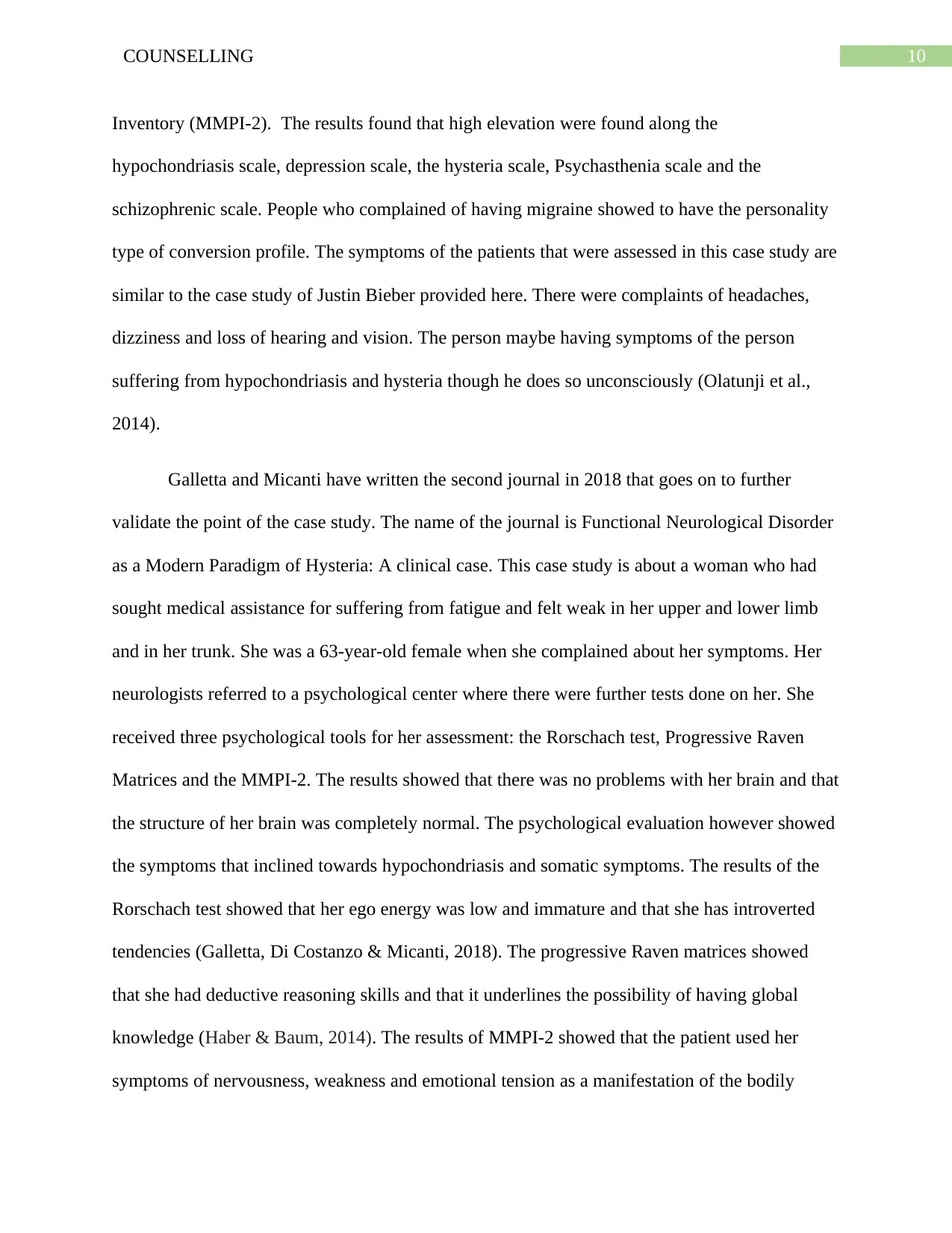
10COUNSELLING
Inventory (MMPI-2). The results found that high elevation were found along the
hypochondriasis scale, depression scale, the hysteria scale, Psychasthenia scale and the
schizophrenic scale. People who complained of having migraine showed to have the personality
type of conversion profile. The symptoms of the patients that were assessed in this case study are
similar to the case study of Justin Bieber provided here. There were complaints of headaches,
dizziness and loss of hearing and vision. The person maybe having symptoms of the person
suffering from hypochondriasis and hysteria though he does so unconsciously (Olatunji et al.,
2014).
Galletta and Micanti have written the second journal in 2018 that goes on to further
validate the point of the case study. The name of the journal is Functional Neurological Disorder
as a Modern Paradigm of Hysteria: A clinical case. This case study is about a woman who had
sought medical assistance for suffering from fatigue and felt weak in her upper and lower limb
and in her trunk. She was a 63-year-old female when she complained about her symptoms. Her
neurologists referred to a psychological center where there were further tests done on her. She
received three psychological tools for her assessment: the Rorschach test, Progressive Raven
Matrices and the MMPI-2. The results showed that there was no problems with her brain and that
the structure of her brain was completely normal. The psychological evaluation however showed
the symptoms that inclined towards hypochondriasis and somatic symptoms. The results of the
Rorschach test showed that her ego energy was low and immature and that she has introverted
tendencies (Galletta, Di Costanzo & Micanti, 2018). The progressive Raven matrices showed
that she had deductive reasoning skills and that it underlines the possibility of having global
knowledge (Haber & Baum, 2014). The results of MMPI-2 showed that the patient used her
symptoms of nervousness, weakness and emotional tension as a manifestation of the bodily
Inventory (MMPI-2). The results found that high elevation were found along the
hypochondriasis scale, depression scale, the hysteria scale, Psychasthenia scale and the
schizophrenic scale. People who complained of having migraine showed to have the personality
type of conversion profile. The symptoms of the patients that were assessed in this case study are
similar to the case study of Justin Bieber provided here. There were complaints of headaches,
dizziness and loss of hearing and vision. The person maybe having symptoms of the person
suffering from hypochondriasis and hysteria though he does so unconsciously (Olatunji et al.,
2014).
Galletta and Micanti have written the second journal in 2018 that goes on to further
validate the point of the case study. The name of the journal is Functional Neurological Disorder
as a Modern Paradigm of Hysteria: A clinical case. This case study is about a woman who had
sought medical assistance for suffering from fatigue and felt weak in her upper and lower limb
and in her trunk. She was a 63-year-old female when she complained about her symptoms. Her
neurologists referred to a psychological center where there were further tests done on her. She
received three psychological tools for her assessment: the Rorschach test, Progressive Raven
Matrices and the MMPI-2. The results showed that there was no problems with her brain and that
the structure of her brain was completely normal. The psychological evaluation however showed
the symptoms that inclined towards hypochondriasis and somatic symptoms. The results of the
Rorschach test showed that her ego energy was low and immature and that she has introverted
tendencies (Galletta, Di Costanzo & Micanti, 2018). The progressive Raven matrices showed
that she had deductive reasoning skills and that it underlines the possibility of having global
knowledge (Haber & Baum, 2014). The results of MMPI-2 showed that the patient used her
symptoms of nervousness, weakness and emotional tension as a manifestation of the bodily
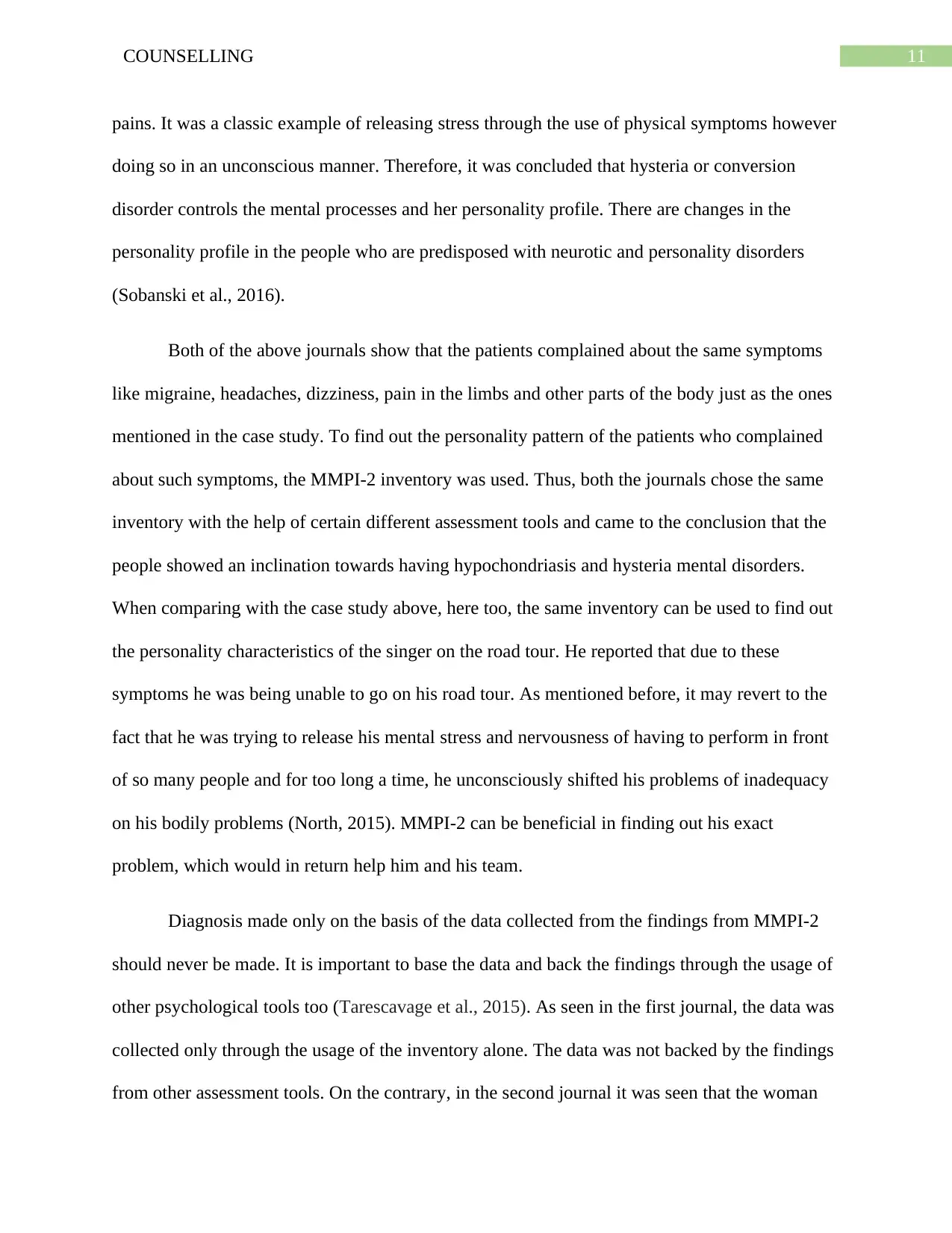
11COUNSELLING
pains. It was a classic example of releasing stress through the use of physical symptoms however
doing so in an unconscious manner. Therefore, it was concluded that hysteria or conversion
disorder controls the mental processes and her personality profile. There are changes in the
personality profile in the people who are predisposed with neurotic and personality disorders
(Sobanski et al., 2016).
Both of the above journals show that the patients complained about the same symptoms
like migraine, headaches, dizziness, pain in the limbs and other parts of the body just as the ones
mentioned in the case study. To find out the personality pattern of the patients who complained
about such symptoms, the MMPI-2 inventory was used. Thus, both the journals chose the same
inventory with the help of certain different assessment tools and came to the conclusion that the
people showed an inclination towards having hypochondriasis and hysteria mental disorders.
When comparing with the case study above, here too, the same inventory can be used to find out
the personality characteristics of the singer on the road tour. He reported that due to these
symptoms he was being unable to go on his road tour. As mentioned before, it may revert to the
fact that he was trying to release his mental stress and nervousness of having to perform in front
of so many people and for too long a time, he unconsciously shifted his problems of inadequacy
on his bodily problems (North, 2015). MMPI-2 can be beneficial in finding out his exact
problem, which would in return help him and his team.
Diagnosis made only on the basis of the data collected from the findings from MMPI-2
should never be made. It is important to base the data and back the findings through the usage of
other psychological tools too (Tarescavage et al., 2015). As seen in the first journal, the data was
collected only through the usage of the inventory alone. The data was not backed by the findings
from other assessment tools. On the contrary, in the second journal it was seen that the woman
pains. It was a classic example of releasing stress through the use of physical symptoms however
doing so in an unconscious manner. Therefore, it was concluded that hysteria or conversion
disorder controls the mental processes and her personality profile. There are changes in the
personality profile in the people who are predisposed with neurotic and personality disorders
(Sobanski et al., 2016).
Both of the above journals show that the patients complained about the same symptoms
like migraine, headaches, dizziness, pain in the limbs and other parts of the body just as the ones
mentioned in the case study. To find out the personality pattern of the patients who complained
about such symptoms, the MMPI-2 inventory was used. Thus, both the journals chose the same
inventory with the help of certain different assessment tools and came to the conclusion that the
people showed an inclination towards having hypochondriasis and hysteria mental disorders.
When comparing with the case study above, here too, the same inventory can be used to find out
the personality characteristics of the singer on the road tour. He reported that due to these
symptoms he was being unable to go on his road tour. As mentioned before, it may revert to the
fact that he was trying to release his mental stress and nervousness of having to perform in front
of so many people and for too long a time, he unconsciously shifted his problems of inadequacy
on his bodily problems (North, 2015). MMPI-2 can be beneficial in finding out his exact
problem, which would in return help him and his team.
Diagnosis made only on the basis of the data collected from the findings from MMPI-2
should never be made. It is important to base the data and back the findings through the usage of
other psychological tools too (Tarescavage et al., 2015). As seen in the first journal, the data was
collected only through the usage of the inventory alone. The data was not backed by the findings
from other assessment tools. On the contrary, in the second journal it was seen that the woman
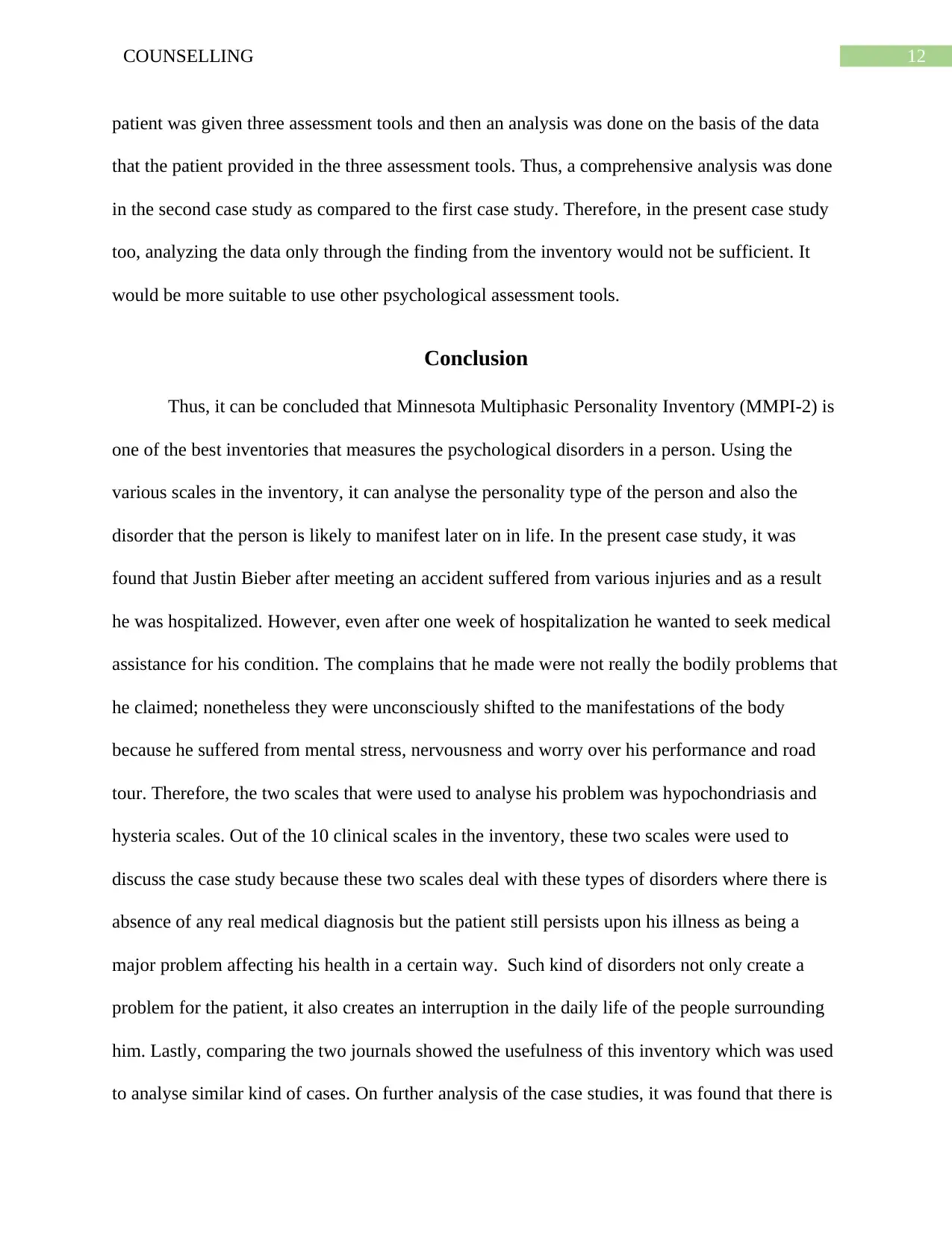
12COUNSELLING
patient was given three assessment tools and then an analysis was done on the basis of the data
that the patient provided in the three assessment tools. Thus, a comprehensive analysis was done
in the second case study as compared to the first case study. Therefore, in the present case study
too, analyzing the data only through the finding from the inventory would not be sufficient. It
would be more suitable to use other psychological assessment tools.
Conclusion
Thus, it can be concluded that Minnesota Multiphasic Personality Inventory (MMPI-2) is
one of the best inventories that measures the psychological disorders in a person. Using the
various scales in the inventory, it can analyse the personality type of the person and also the
disorder that the person is likely to manifest later on in life. In the present case study, it was
found that Justin Bieber after meeting an accident suffered from various injuries and as a result
he was hospitalized. However, even after one week of hospitalization he wanted to seek medical
assistance for his condition. The complains that he made were not really the bodily problems that
he claimed; nonetheless they were unconsciously shifted to the manifestations of the body
because he suffered from mental stress, nervousness and worry over his performance and road
tour. Therefore, the two scales that were used to analyse his problem was hypochondriasis and
hysteria scales. Out of the 10 clinical scales in the inventory, these two scales were used to
discuss the case study because these two scales deal with these types of disorders where there is
absence of any real medical diagnosis but the patient still persists upon his illness as being a
major problem affecting his health in a certain way. Such kind of disorders not only create a
problem for the patient, it also creates an interruption in the daily life of the people surrounding
him. Lastly, comparing the two journals showed the usefulness of this inventory which was used
to analyse similar kind of cases. On further analysis of the case studies, it was found that there is
patient was given three assessment tools and then an analysis was done on the basis of the data
that the patient provided in the three assessment tools. Thus, a comprehensive analysis was done
in the second case study as compared to the first case study. Therefore, in the present case study
too, analyzing the data only through the finding from the inventory would not be sufficient. It
would be more suitable to use other psychological assessment tools.
Conclusion
Thus, it can be concluded that Minnesota Multiphasic Personality Inventory (MMPI-2) is
one of the best inventories that measures the psychological disorders in a person. Using the
various scales in the inventory, it can analyse the personality type of the person and also the
disorder that the person is likely to manifest later on in life. In the present case study, it was
found that Justin Bieber after meeting an accident suffered from various injuries and as a result
he was hospitalized. However, even after one week of hospitalization he wanted to seek medical
assistance for his condition. The complains that he made were not really the bodily problems that
he claimed; nonetheless they were unconsciously shifted to the manifestations of the body
because he suffered from mental stress, nervousness and worry over his performance and road
tour. Therefore, the two scales that were used to analyse his problem was hypochondriasis and
hysteria scales. Out of the 10 clinical scales in the inventory, these two scales were used to
discuss the case study because these two scales deal with these types of disorders where there is
absence of any real medical diagnosis but the patient still persists upon his illness as being a
major problem affecting his health in a certain way. Such kind of disorders not only create a
problem for the patient, it also creates an interruption in the daily life of the people surrounding
him. Lastly, comparing the two journals showed the usefulness of this inventory which was used
to analyse similar kind of cases. On further analysis of the case studies, it was found that there is
Paraphrase This Document
Need a fresh take? Get an instant paraphrase of this document with our AI Paraphraser

13COUNSELLING
a need for other psychological assessment tools for establishing the findings made by this
inventory. Thus, it can be said that MMPI-2 is a useful inventory that can find out many aspects
of psychopathology and many facets of personality domain.
a need for other psychological assessment tools for establishing the findings made by this
inventory. Thus, it can be said that MMPI-2 is a useful inventory that can find out many aspects
of psychopathology and many facets of personality domain.
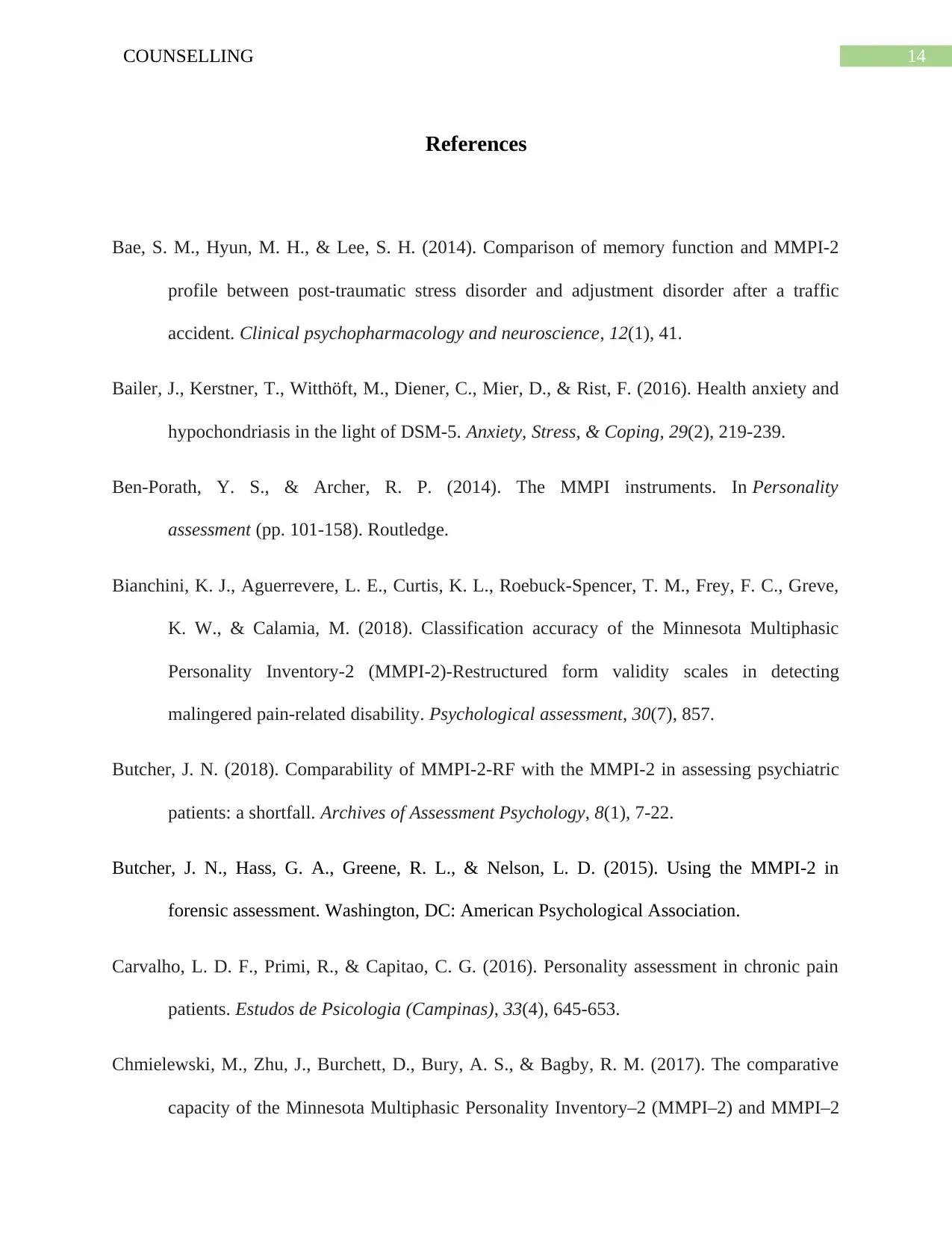
14COUNSELLING
References
Bae, S. M., Hyun, M. H., & Lee, S. H. (2014). Comparison of memory function and MMPI-2
profile between post-traumatic stress disorder and adjustment disorder after a traffic
accident. Clinical psychopharmacology and neuroscience, 12(1), 41.
Bailer, J., Kerstner, T., Witthöft, M., Diener, C., Mier, D., & Rist, F. (2016). Health anxiety and
hypochondriasis in the light of DSM-5. Anxiety, Stress, & Coping, 29(2), 219-239.
Ben-Porath, Y. S., & Archer, R. P. (2014). The MMPI instruments. In Personality
assessment (pp. 101-158). Routledge.
Bianchini, K. J., Aguerrevere, L. E., Curtis, K. L., Roebuck-Spencer, T. M., Frey, F. C., Greve,
K. W., & Calamia, M. (2018). Classification accuracy of the Minnesota Multiphasic
Personality Inventory-2 (MMPI-2)-Restructured form validity scales in detecting
malingered pain-related disability. Psychological assessment, 30(7), 857.
Butcher, J. N. (2018). Comparability of MMPI-2-RF with the MMPI-2 in assessing psychiatric
patients: a shortfall. Archives of Assessment Psychology, 8(1), 7-22.
Butcher, J. N., Hass, G. A., Greene, R. L., & Nelson, L. D. (2015). Using the MMPI-2 in
forensic assessment. Washington, DC: American Psychological Association.
Carvalho, L. D. F., Primi, R., & Capitao, C. G. (2016). Personality assessment in chronic pain
patients. Estudos de Psicologia (Campinas), 33(4), 645-653.
Chmielewski, M., Zhu, J., Burchett, D., Bury, A. S., & Bagby, R. M. (2017). The comparative
capacity of the Minnesota Multiphasic Personality Inventory–2 (MMPI–2) and MMPI–2
References
Bae, S. M., Hyun, M. H., & Lee, S. H. (2014). Comparison of memory function and MMPI-2
profile between post-traumatic stress disorder and adjustment disorder after a traffic
accident. Clinical psychopharmacology and neuroscience, 12(1), 41.
Bailer, J., Kerstner, T., Witthöft, M., Diener, C., Mier, D., & Rist, F. (2016). Health anxiety and
hypochondriasis in the light of DSM-5. Anxiety, Stress, & Coping, 29(2), 219-239.
Ben-Porath, Y. S., & Archer, R. P. (2014). The MMPI instruments. In Personality
assessment (pp. 101-158). Routledge.
Bianchini, K. J., Aguerrevere, L. E., Curtis, K. L., Roebuck-Spencer, T. M., Frey, F. C., Greve,
K. W., & Calamia, M. (2018). Classification accuracy of the Minnesota Multiphasic
Personality Inventory-2 (MMPI-2)-Restructured form validity scales in detecting
malingered pain-related disability. Psychological assessment, 30(7), 857.
Butcher, J. N. (2018). Comparability of MMPI-2-RF with the MMPI-2 in assessing psychiatric
patients: a shortfall. Archives of Assessment Psychology, 8(1), 7-22.
Butcher, J. N., Hass, G. A., Greene, R. L., & Nelson, L. D. (2015). Using the MMPI-2 in
forensic assessment. Washington, DC: American Psychological Association.
Carvalho, L. D. F., Primi, R., & Capitao, C. G. (2016). Personality assessment in chronic pain
patients. Estudos de Psicologia (Campinas), 33(4), 645-653.
Chmielewski, M., Zhu, J., Burchett, D., Bury, A. S., & Bagby, R. M. (2017). The comparative
capacity of the Minnesota Multiphasic Personality Inventory–2 (MMPI–2) and MMPI–2
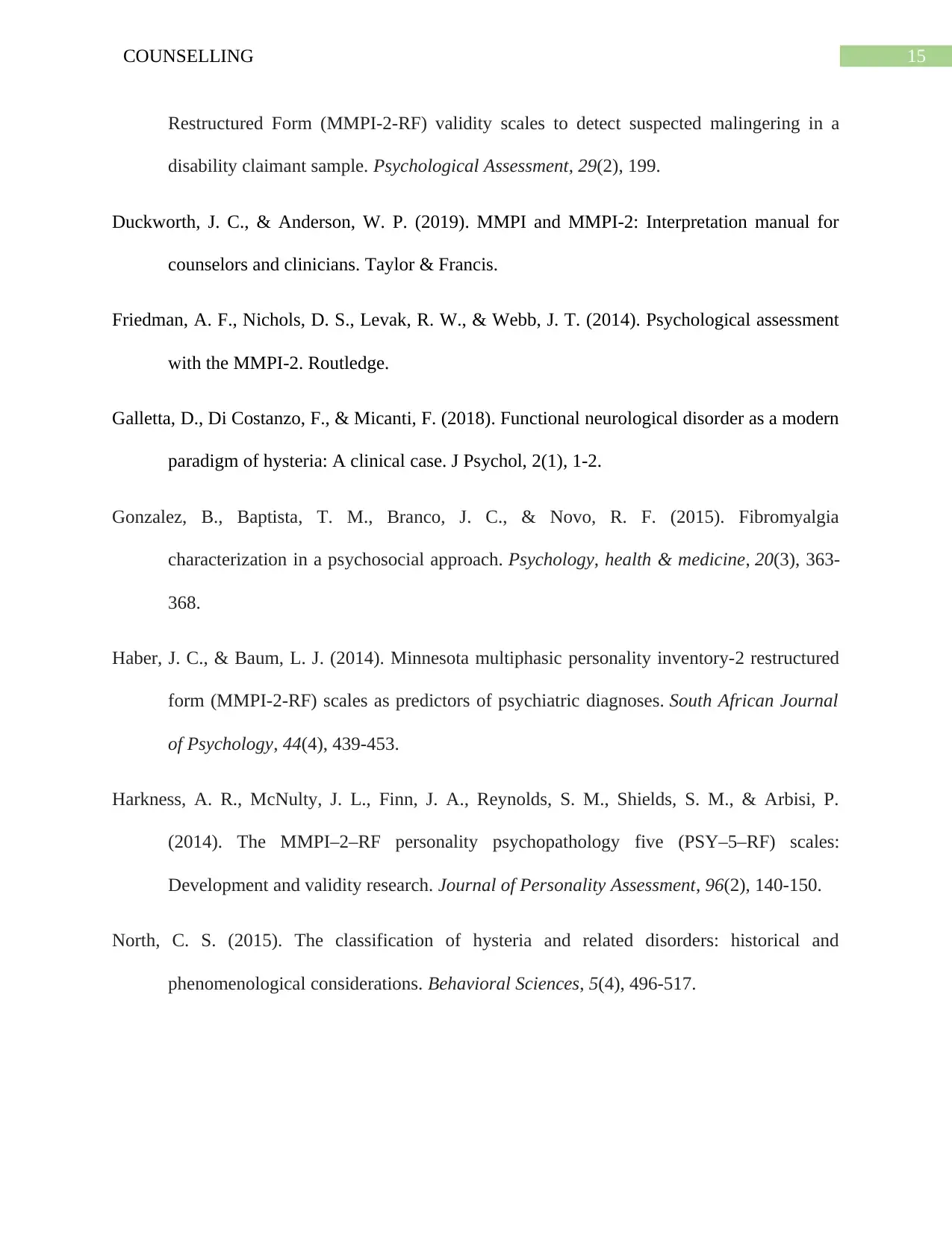
15COUNSELLING
Restructured Form (MMPI-2-RF) validity scales to detect suspected malingering in a
disability claimant sample. Psychological Assessment, 29(2), 199.
Duckworth, J. C., & Anderson, W. P. (2019). MMPI and MMPI-2: Interpretation manual for
counselors and clinicians. Taylor & Francis.
Friedman, A. F., Nichols, D. S., Levak, R. W., & Webb, J. T. (2014). Psychological assessment
with the MMPI-2. Routledge.
Galletta, D., Di Costanzo, F., & Micanti, F. (2018). Functional neurological disorder as a modern
paradigm of hysteria: A clinical case. J Psychol, 2(1), 1-2.
Gonzalez, B., Baptista, T. M., Branco, J. C., & Novo, R. F. (2015). Fibromyalgia
characterization in a psychosocial approach. Psychology, health & medicine, 20(3), 363-
368.
Haber, J. C., & Baum, L. J. (2014). Minnesota multiphasic personality inventory-2 restructured
form (MMPI-2-RF) scales as predictors of psychiatric diagnoses. South African Journal
of Psychology, 44(4), 439-453.
Harkness, A. R., McNulty, J. L., Finn, J. A., Reynolds, S. M., Shields, S. M., & Arbisi, P.
(2014). The MMPI–2–RF personality psychopathology five (PSY–5–RF) scales:
Development and validity research. Journal of Personality Assessment, 96(2), 140-150.
North, C. S. (2015). The classification of hysteria and related disorders: historical and
phenomenological considerations. Behavioral Sciences, 5(4), 496-517.
Restructured Form (MMPI-2-RF) validity scales to detect suspected malingering in a
disability claimant sample. Psychological Assessment, 29(2), 199.
Duckworth, J. C., & Anderson, W. P. (2019). MMPI and MMPI-2: Interpretation manual for
counselors and clinicians. Taylor & Francis.
Friedman, A. F., Nichols, D. S., Levak, R. W., & Webb, J. T. (2014). Psychological assessment
with the MMPI-2. Routledge.
Galletta, D., Di Costanzo, F., & Micanti, F. (2018). Functional neurological disorder as a modern
paradigm of hysteria: A clinical case. J Psychol, 2(1), 1-2.
Gonzalez, B., Baptista, T. M., Branco, J. C., & Novo, R. F. (2015). Fibromyalgia
characterization in a psychosocial approach. Psychology, health & medicine, 20(3), 363-
368.
Haber, J. C., & Baum, L. J. (2014). Minnesota multiphasic personality inventory-2 restructured
form (MMPI-2-RF) scales as predictors of psychiatric diagnoses. South African Journal
of Psychology, 44(4), 439-453.
Harkness, A. R., McNulty, J. L., Finn, J. A., Reynolds, S. M., Shields, S. M., & Arbisi, P.
(2014). The MMPI–2–RF personality psychopathology five (PSY–5–RF) scales:
Development and validity research. Journal of Personality Assessment, 96(2), 140-150.
North, C. S. (2015). The classification of hysteria and related disorders: historical and
phenomenological considerations. Behavioral Sciences, 5(4), 496-517.
Secure Best Marks with AI Grader
Need help grading? Try our AI Grader for instant feedback on your assignments.
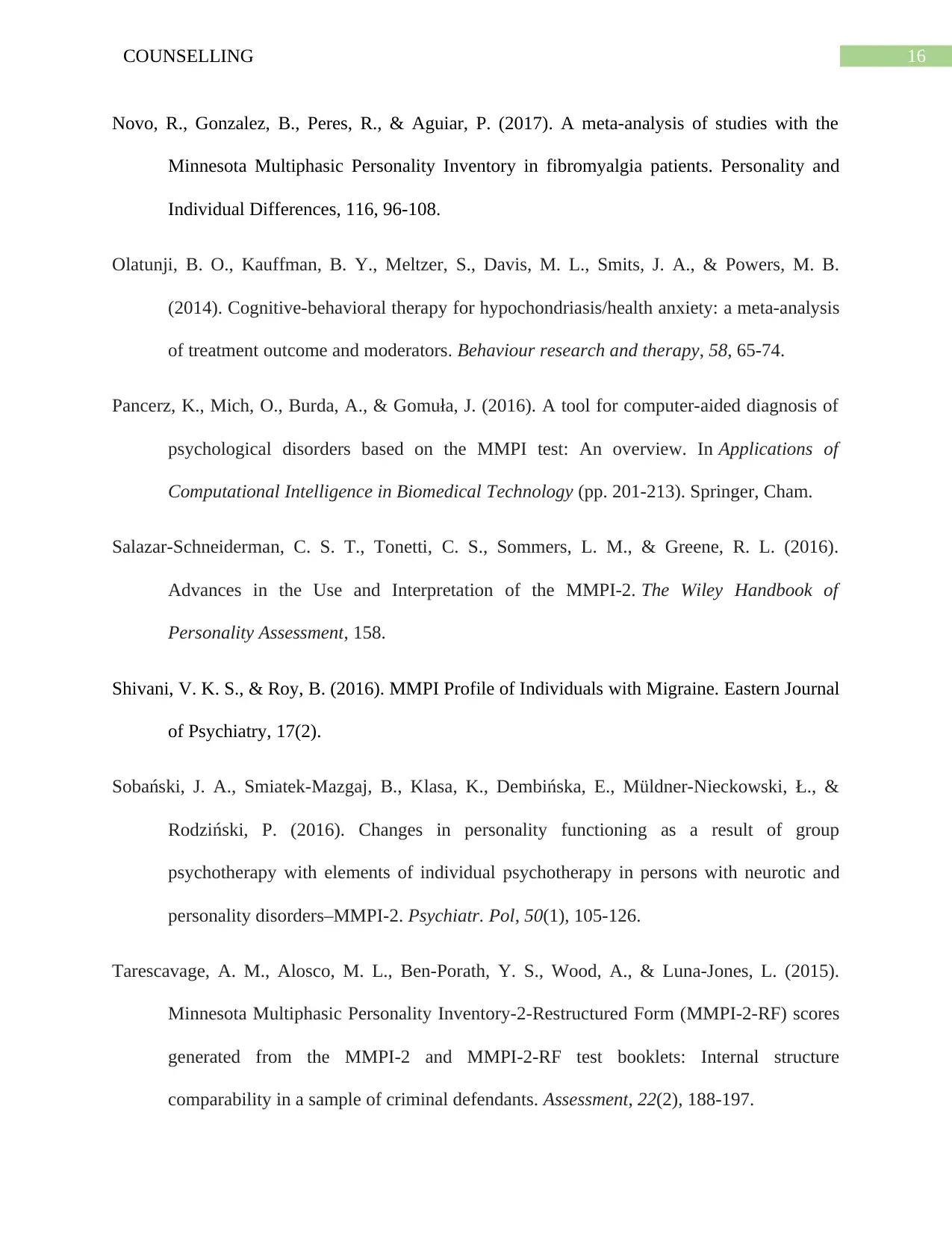
16COUNSELLING
Novo, R., Gonzalez, B., Peres, R., & Aguiar, P. (2017). A meta-analysis of studies with the
Minnesota Multiphasic Personality Inventory in fibromyalgia patients. Personality and
Individual Differences, 116, 96-108.
Olatunji, B. O., Kauffman, B. Y., Meltzer, S., Davis, M. L., Smits, J. A., & Powers, M. B.
(2014). Cognitive-behavioral therapy for hypochondriasis/health anxiety: a meta-analysis
of treatment outcome and moderators. Behaviour research and therapy, 58, 65-74.
Pancerz, K., Mich, O., Burda, A., & Gomuła, J. (2016). A tool for computer-aided diagnosis of
psychological disorders based on the MMPI test: An overview. In Applications of
Computational Intelligence in Biomedical Technology (pp. 201-213). Springer, Cham.
Salazar‐Schneiderman, C. S. T., Tonetti, C. S., Sommers, L. M., & Greene, R. L. (2016).
Advances in the Use and Interpretation of the MMPI‐2. The Wiley Handbook of
Personality Assessment, 158.
Shivani, V. K. S., & Roy, B. (2016). MMPI Profile of Individuals with Migraine. Eastern Journal
of Psychiatry, 17(2).
Sobański, J. A., Smiatek-Mazgaj, B., Klasa, K., Dembińska, E., Müldner-Nieckowski, Ł., &
Rodziński, P. (2016). Changes in personality functioning as a result of group
psychotherapy with elements of individual psychotherapy in persons with neurotic and
personality disorders–MMPI-2. Psychiatr. Pol, 50(1), 105-126.
Tarescavage, A. M., Alosco, M. L., Ben-Porath, Y. S., Wood, A., & Luna-Jones, L. (2015).
Minnesota Multiphasic Personality Inventory-2-Restructured Form (MMPI-2-RF) scores
generated from the MMPI-2 and MMPI-2-RF test booklets: Internal structure
comparability in a sample of criminal defendants. Assessment, 22(2), 188-197.
Novo, R., Gonzalez, B., Peres, R., & Aguiar, P. (2017). A meta-analysis of studies with the
Minnesota Multiphasic Personality Inventory in fibromyalgia patients. Personality and
Individual Differences, 116, 96-108.
Olatunji, B. O., Kauffman, B. Y., Meltzer, S., Davis, M. L., Smits, J. A., & Powers, M. B.
(2014). Cognitive-behavioral therapy for hypochondriasis/health anxiety: a meta-analysis
of treatment outcome and moderators. Behaviour research and therapy, 58, 65-74.
Pancerz, K., Mich, O., Burda, A., & Gomuła, J. (2016). A tool for computer-aided diagnosis of
psychological disorders based on the MMPI test: An overview. In Applications of
Computational Intelligence in Biomedical Technology (pp. 201-213). Springer, Cham.
Salazar‐Schneiderman, C. S. T., Tonetti, C. S., Sommers, L. M., & Greene, R. L. (2016).
Advances in the Use and Interpretation of the MMPI‐2. The Wiley Handbook of
Personality Assessment, 158.
Shivani, V. K. S., & Roy, B. (2016). MMPI Profile of Individuals with Migraine. Eastern Journal
of Psychiatry, 17(2).
Sobański, J. A., Smiatek-Mazgaj, B., Klasa, K., Dembińska, E., Müldner-Nieckowski, Ł., &
Rodziński, P. (2016). Changes in personality functioning as a result of group
psychotherapy with elements of individual psychotherapy in persons with neurotic and
personality disorders–MMPI-2. Psychiatr. Pol, 50(1), 105-126.
Tarescavage, A. M., Alosco, M. L., Ben-Porath, Y. S., Wood, A., & Luna-Jones, L. (2015).
Minnesota Multiphasic Personality Inventory-2-Restructured Form (MMPI-2-RF) scores
generated from the MMPI-2 and MMPI-2-RF test booklets: Internal structure
comparability in a sample of criminal defendants. Assessment, 22(2), 188-197.
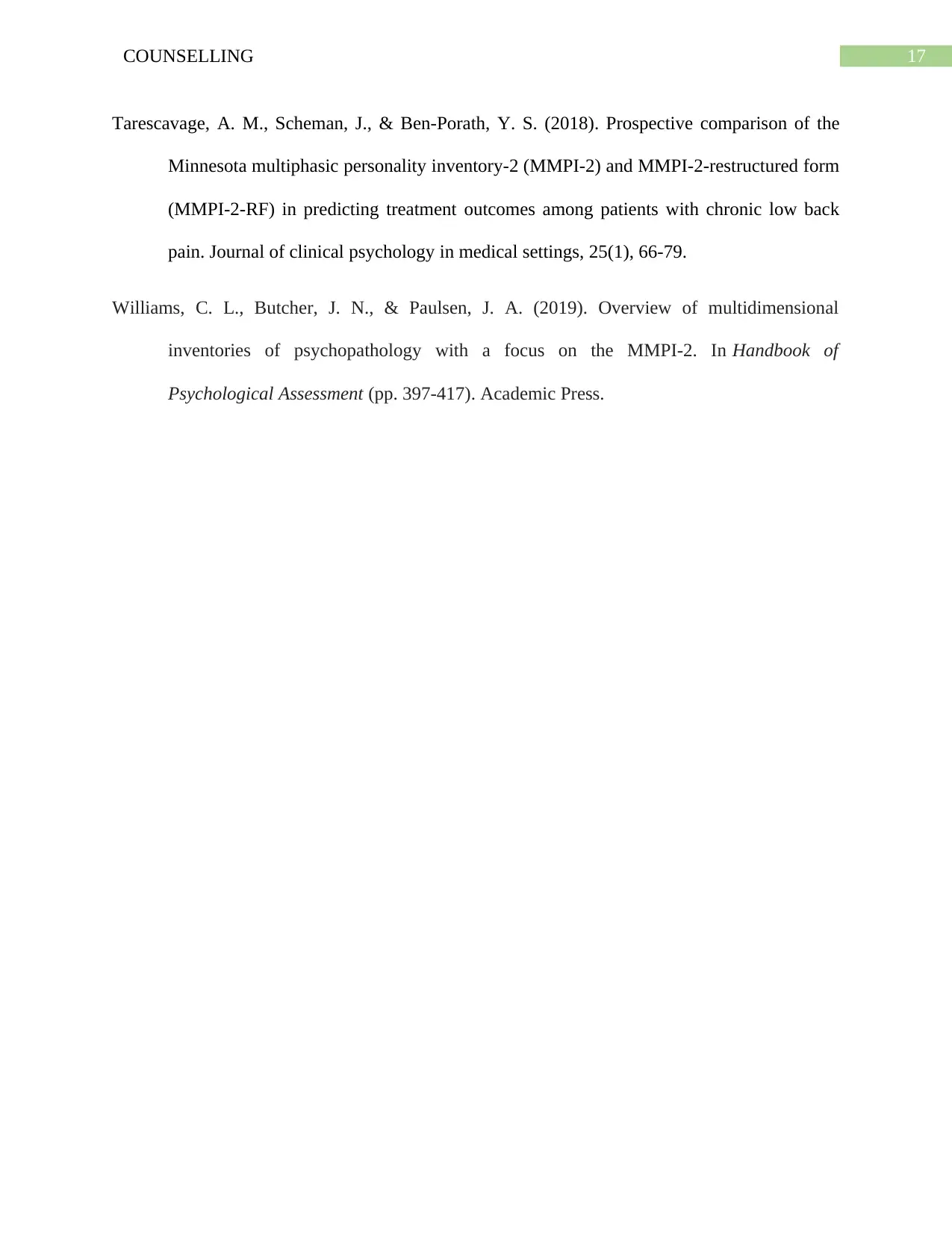
17COUNSELLING
Tarescavage, A. M., Scheman, J., & Ben-Porath, Y. S. (2018). Prospective comparison of the
Minnesota multiphasic personality inventory-2 (MMPI-2) and MMPI-2-restructured form
(MMPI-2-RF) in predicting treatment outcomes among patients with chronic low back
pain. Journal of clinical psychology in medical settings, 25(1), 66-79.
Williams, C. L., Butcher, J. N., & Paulsen, J. A. (2019). Overview of multidimensional
inventories of psychopathology with a focus on the MMPI-2. In Handbook of
Psychological Assessment (pp. 397-417). Academic Press.
Tarescavage, A. M., Scheman, J., & Ben-Porath, Y. S. (2018). Prospective comparison of the
Minnesota multiphasic personality inventory-2 (MMPI-2) and MMPI-2-restructured form
(MMPI-2-RF) in predicting treatment outcomes among patients with chronic low back
pain. Journal of clinical psychology in medical settings, 25(1), 66-79.
Williams, C. L., Butcher, J. N., & Paulsen, J. A. (2019). Overview of multidimensional
inventories of psychopathology with a focus on the MMPI-2. In Handbook of
Psychological Assessment (pp. 397-417). Academic Press.
1 out of 18
Related Documents
Your All-in-One AI-Powered Toolkit for Academic Success.
+13062052269
info@desklib.com
Available 24*7 on WhatsApp / Email
![[object Object]](/_next/static/media/star-bottom.7253800d.svg)
Unlock your academic potential
© 2024 | Zucol Services PVT LTD | All rights reserved.





